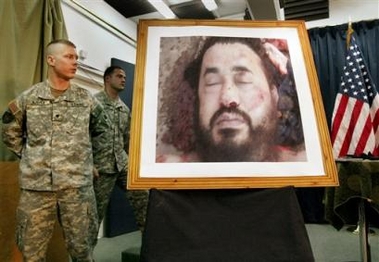Abu Musab al-Zarqawi could barely speak, but he struggled and tried to get
away from American soldiers as he lay dying on a stretcher in the ruins of his
hideout.
The US forces recognized his face, and knew they had the leader of al-Qaida
in Iraq.

U.S. soldier at a
press conference in Baghdad, Iraq looks across at a photo purporting to
show the body of Abu Musab al-Zarqawi, the al-Qaida-linked militant who
led a bloody campaign of suicide bombings, kidnappings and hostage
beheadings in Iraq, who was killed Wednesday in a US airstrike, Iraq's
Prime Minister Nouri al-Maliki announced Thursday, June 8, 2006.
[AP] |
Initially, the US military had said al-Zarqawi was killed outright. But
Friday new details emerged of his final moments.
For three years, al-Zarqawi orchestrated horrific acts of violence guided by
his extremist vision of jihad, or holy war ¡ª first against the U.S. soldiers he
considered occupiers of Arab lands, then against the Shiites he considered
infidels.
On Wednesday, the US military tracked him to a house northwest of Baghdad,
and blew it up with two 500-pound bombs.
Al-Zarqawi somehow managed to survive the impact of the bombs, weapons so
powerful they tore a huge crater in the date palm forest where the house was
nestled just outside the town of Baqouba.
Iraqi police reached the scene first, and found the 39-year-old al-Zarqawi
alive.
"He mumbled something, but it was indistinguishable and it was very short,"
Maj. Gen. William Caldwell, spokesman for US-led forces in Iraq, said Friday of
the Jordanian-born terrorist's last words.
Iraqi police pulled him from the flattened home and placed him on a makeshift
stretcher. U.S. troops arrived, saw that al-Zarqawi was conscious, and tried to
provide medical treatment, the spokesman said.
"He obviously had some kind of visual recognition of who they were because he
attempted to roll off the stretcher, as I am told, and get away, realizing it
was the U.S. military," Caldwell told Pentagon reporters via videoconference
from Baghdad.
Al-Zarqawi "attempted to, sort of, turn away off the stretcher," he said.
"Everybody re-secured him back onto the stretcher, but he died almost
immediately thereafter from the wounds he'd received from this airstrike."
So much blood covered al-Zarqawi's body that US forces cleaned him up before
taking photographs. "Despite the fact that this person actually had no regard
for human life, we were not going to treat him in the same manner," Caldwell
said.
The airstrike killed two other men and three women who were in the house, but
only al-Zarqawi and his spiritual adviser have been positively identified, he
said.
Caldwell also said experts told him it is not unheard of for people to
survive a blast of that magnitude.
"There are cases when people, in fact, can survive even an attack like that
on a building structure. Obviously, the other five in the building did not, but
he did for some reason," Caldwell said.
He said he did not know if al-Zarqawi was inside or outside the house when
the bombs struck.
"Well, what we had found, as with anything, first reports are not always
fully accurate as we continue the debriefings. But we were not aware yesterday
that, in fact, Zarqawi was alive when U.S. forces arrived on the site," Caldwell
said.
His recounting of the aftermath of the airstrike could not be independently
verified. The Iraqi government confirmed only that Iraqi forces were first on
the scene, followed by the Americans.
An aide to Prime Minister Nouri al-Maliki, speaking on condition of anonymity
because he was not authorized to talk to the media, said he saw Caldwell's news
briefing but could neither confirm nor deny that al-Zarqawi briefly survived the
blast.
"Well, I think it's clear: The Americans said he was seriously wounded and he
died," the aide said.